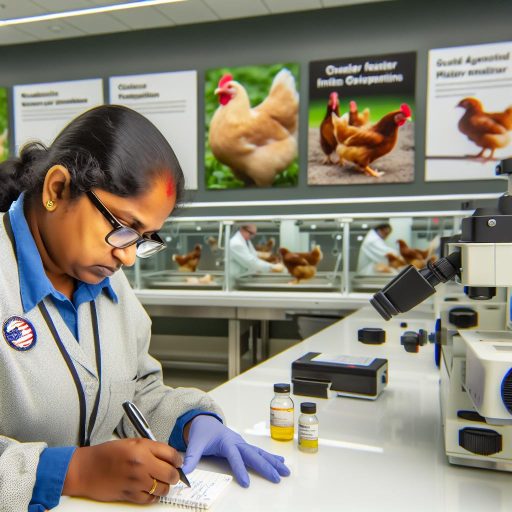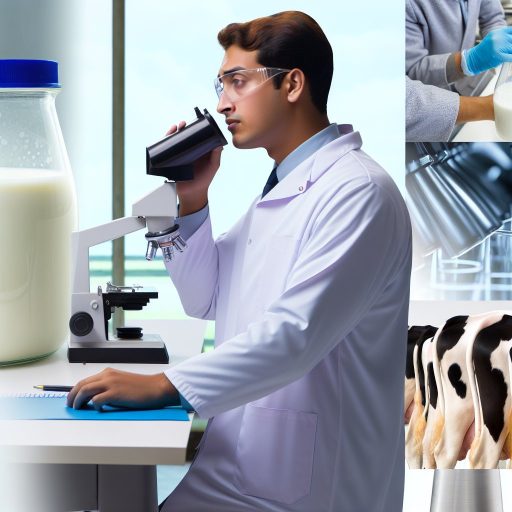Introduction:
Pest management involves the control and elimination of pests that can harm crops.
Plant pathology focuses on the study of diseases that affect plants.
Understanding the differences between the two fields is crucial for proper agricultural practices.
Definition of Pest Management:
Techniques used to control and eliminate pests.
Examples of common pests in agriculture and urban settings.
Pest Management Techniques:
Pest management involves a variety of techniques to control and eliminate pests.
These techniques can be categorized into several methods:
-
Biological Control: This method involves the use of natural enemies of pests to control their population.
Predators, parasites, and pathogens are commonly used in biological control.
-
Chemical Control: Pesticides are commonly used in pest management to kill or repel pests.
However, chemical control should be used as a last resort due to environmental and health concerns.
-
Cultural Control: This method involves modifying the environment to make it less hospitable for pests.
Crop rotation, maintaining proper sanitation, and planting pest-resistant varieties are examples of cultural control.
-
Mechanical Control: Physical barriers, traps, and hand-picking are examples of mechanical control techniques used to physically
remove pests from the environment.
-
Genetic Control: This method involves using genetically modified organisms (GMOs) to control pest populations.
GMOs can be engineered to produce toxins that are harmful to pests.
Common Pests in Agriculture:
-
Insects: Insects like aphids, caterpillars, and beetles can cause significant damage to crops by
feeding on plant tissues.
-
Rodents: Mice and rats can consume and contaminate crops, leading to yield losses and food
safety issues.
-
Weeds: Weeds compete with crops for resources like water, nutrients, and sunlight, reducing crop
yields.
-
Pathogens: Fungi, bacteria, and viruses can cause plant diseases, leading to reduced crop
quality and yield.
Common Pests in Urban Settings:
-
Cockroaches: Cockroaches are common indoor pests that can spread diseases and trigger allergies.
-
Ants: Ants can invade homes in search of food and water, becoming a nuisance to
homeowners.
-
Termites: Termites can cause significant structural damage to buildings and homes if left
unchecked.
-
Mice and Rats: These pests can contaminate food, spread diseases, and damage property
in urban areas.
Pest management plays a crucial role in protecting crops, structures, and human health from the harmful effects of pests.
By employing a combination of techniques tailored to specific pest problems, individuals and organizations can effectively manage and mitigate pest issues in both agricultural and urban settings.
Remember, prevention is key in pest management to minimize the need for more drastic control measures.
Plant Pathology is the study of plant diseases and their management.
Understanding Plant Pathology:
Plant pathology is a branch of science that deals with the study of diseases that affect plants.
These diseases can be caused by various factors, including fungi, bacteria, viruses, nematodes, and environmental stresses.
- Identification of Plant Diseases: One of the key aspects of plant pathology is identifying the diseases that affect plants. This involves studying the symptoms exhibited by plants, conducting laboratory tests, and using other diagnostic tools to determine the cause of the disease.
- Treating Plant Diseases: Once plant diseases are identified, plant pathologists work on developing management strategies to control and prevent the spread of diseases. This can involve the use of chemical treatments, biological control methods, cultural practices, and resistant plant varieties.
- Importance of Plant Pathology: Plant pathology plays a crucial role in agriculture and horticulture as it helps in maintaining plant health and ensuring crop productivity. By understanding plant diseases and their management, farmers can protect their crops and improve yield.
Challenges in Plant Pathology:
Plant pathologists face various challenges in their field, including the emergence of new diseases, development of resistance to chemical treatments, and environmental factors that contribute to the spread of diseases.
These challenges require constant research and innovation to develop effective strategies for disease management.
- Research and Innovation: Plant pathologists conduct research to better understand the mechanisms of plant diseases and develop innovative solutions for disease management. This involves studying disease cycles, host-pathogen interactions, and methods for disease control.
- Educational Outreach: Plant pathologists also play a role in educating farmers, gardeners, and the general public about plant diseases and the importance of disease management. By raising awareness and providing information, they help in preventing the spread of diseases and promoting sustainable agriculture practices.
- Collaboration and Networking: Plant pathologists collaborate with other researchers, government agencies, and industry partners to address the challenges in plant pathology. By working together, they can share knowledge, resources, and expertise to develop comprehensive solutions for disease management.
Future Directions in Plant Pathology:
As the agriculture industry continues to evolve, the role of plant pathology becomes increasingly important.
With the growing demand for food production and the challenges posed by climate change and globalization, plant pathologists will play a crucial role in ensuring the sustainability and security of our food supply.
- Advances in Technology: Plant pathology is benefiting from advances in technology, such as molecular biology, genomics, and bioinformatics, which allow for more accurate and efficient diagnosis of plant diseases. These technologies also help in developing new tools and strategies for disease management.
- Sustainable Agriculture: Plant pathologists are advocating for sustainable agriculture practices that promote plant health and reduce the reliance on chemical treatments. By focusing on integrated pest management, crop rotation, and biological control, they aim to develop environmentally friendly solutions for disease management.
- Global Collaboration: With the increasing globalization of trade and agriculture, plant pathologists are working on collaborative research projects to address global challenges in plant pathology. By sharing knowledge and expertise across borders, they can develop strategies for managing plant diseases on a global scale.
Plant pathology plays a vital role in the management of plant diseases and ensuring the sustainability of agriculture.
By understanding plant diseases, developing effective management strategies, and collaborating with partners, plant pathologists contribute to protecting our food supply and promoting environmental health.
Find Out More: How to Maintain Compliance in Agricultural Lending
Transform Your Career Today
Unlock a personalized career strategy that drives real results. Get tailored advice and a roadmap designed just for you.
Start NowFocus of Pest Management:
Pest management is a crucial aspect of agriculture and property maintenance.
It involves the implementation of various strategies to control and eliminate harmful pests that can cause significant damage.
Let’s delve deeper into the key focus areas of pest management to better understand its importance and impact.
Controlling Pests through Various Methods:
One of the primary objectives of pest management is to control pests effectively using a combination of methods.
These methods include the use of pesticides, traps, and biological control.
Pesticides are chemical substances used to kill or repel pests such as insects, rodents, and weeds.
They are commonly sprayed on crops or applied to the soil to protect plants from damage.
However, pesticide use must be carefully regulated to minimize environmental risks and human health hazards.
Traps are another common method used in pest management to capture and remove pests from the environment.
There are different types of traps, such as sticky traps, pheromone traps, and snap traps, designed to target specific pest species without harming beneficial organisms.
Biological control is a sustainable approach that involves using natural enemies, such as predators, parasites, and pathogens, to control pest populations.
This method is environmentally friendly and helps maintain a balanced ecosystem by reducing the need for chemical pesticides.
Minimizing Damage to Crops, Property, and Human Health:
The ultimate goal of pest management is to minimize the damage caused by pests to crops, property, and human health.
Pests can have devastating effects on agricultural production by reducing crop yields, contaminating food products, and spreading diseases.
By implementing effective pest management strategies, farmers can protect their crops from pest infestations and improve overall yield and quality.
Property owners can also prevent structural damage caused by pests, such as termites, ants, and rodents, by using proper pest control measures.
Furthermore, pests can pose significant health risks to humans by transmitting diseases, allergies, and toxins.
Controlling pests in residential and commercial settings is essential to safeguard human health and well-being.
In summary, pest management plays a vital role in protecting agriculture, property, and public health from the harmful effects of pests.
By focusing on controlling pests through various methods and minimizing damage caused by them, pest management helps maintain a sustainable and healthy environment for all.
Transform Your Career Today
Unlock a personalized career strategy that drives real results. Get tailored advice and a roadmap designed just for you.
Start NowSee Related Content: History and Evolution of Extension Services
Focus of Plant Pathology:
Plant pathology primarily focuses on identifying, preventing, and managing plant diseases.
This field involves studying the causes of diseases, such as pathogens, environmental factors, and genetic susceptibility.
Plant pathology is a crucial field that plays a significant role in ensuring the health and sustainability of plants.
By focusing on issues related to plant diseases, plant pathologists work to identify, prevent, and manage various ailments that can affect plant health and productivity.
One of the primary focuses of plant pathology is to identify the different types of plant diseases that can impact various plant species.
By understanding the signs and symptoms of these diseases, plant pathologists can effectively diagnose and treat affected plants to prevent further damage.
In addition to identifying plant diseases, plant pathology also involves studying the causes of these diseases.
Pathogens, such as bacteria, fungi, viruses, and nematodes, play a significant role in causing plant diseases.
By studying these pathogens, plant pathologists can develop strategies to control and manage their impact on plants.
Environmental factors also play a crucial role in the development of plant diseases.
Factors such as temperature, humidity, and soil conditions can create environments that are conducive to disease development.
Plant pathologists study these environmental factors to understand how they influence the spread and severity of plant diseases.
Furthermore, genetic susceptibility is another critical aspect that plant pathologists consider when studying plant diseases.
Some plant species or cultivars may be more susceptible to certain diseases due to their genetic makeup.
By understanding these genetic vulnerabilities, plant pathologists can develop disease-resistant plant varieties to mitigate the impact of diseases.
Overall, the focus of plant pathology is multifaceted, involving a deep understanding of the various factors that contribute to plant diseases.
By studying pathogens, environmental factors, and genetic susceptibility, plant pathologists play a crucial role in protecting plant health and ensuring the sustainability of agriculture.
Explore Further: Dairy Science Innovations in Developing Countries
Importance of Pest Management in Agriculture:
Pest management plays a significant role in ensuring food security for the growing global population.
Transform Your Career Today
Unlock a personalized career strategy that drives real results. Get tailored advice and a roadmap designed just for you.
Start NowIt helps maximize crop yield by controlling pest populations that can reduce productivity.
Effective pest management practices can protect crops from damage caused by insects, weeds, and other pests.
By preventing crop losses, pest management contributes to overall farm profitability and sustainability.
Integrated Pest Management (IPM) strategies aim to reduce reliance on chemical pesticides and promote environmentally friendly practices.
Proper pest management can also help reduce the spread of plant diseases carried by certain pests.
Farmers who implement good pest management techniques can improve the quality of their produce for consumers.
Investing in pest management early in the growing season can prevent major infestations and costly damage later on.
Through pest management, farmers can better utilize resources such as water, nutrients, and land for sustainable agriculture.
Overall, pest management is essential for maintaining a healthy and productive agricultural system that can meet the needs of a growing population.
See Related Content: Insect Physiology: Fundamental Concepts for Entomologists

Importance of Plant Pathology in Agriculture
Plant pathology plays a crucial role in ensuring the health and productivity of crops.
Here are some key points highlighting its significance:
- Essential for maintaining healthy crops
- Prevents disease outbreaks
- Diagnoses plant diseases accurately
- Treats plant diseases effectively
- Prevents crop loss
- Improves overall crop yield
- Helps in the development of disease-resistant crops
- Contributes to sustainable agriculture practices
Plant pathology is the field of science that focuses on the study of plant diseases, their causes, and management strategies.
By understanding plant diseases and their impact on crop health, plant pathologists can help farmers make informed decisions to protect their crops and ensure food security.
One of the primary goals of plant pathology is to prevent disease outbreaks that can devastate entire crops.
By identifying the pathogens responsible for plant diseases, plant pathologists can develop disease management strategies to control the spread of these pathogens and minimize their impact on crop yield.
This proactive approach helps farmers safeguard their crops and reduce economic losses due to disease.
Furthermore, plant pathology plays a crucial role in diagnosing plant diseases accurately.
Plant pathologists use a combination of techniques, including visual observation, laboratory tests, and molecular analysis, to identify the pathogens causing plant diseases.
This accurate diagnosis is essential for implementing targeted and effective treatment strategies to control the spread of the disease and prevent further crop damage.
Transform Your Career Today
Unlock a personalized career strategy that drives real results. Get tailored advice and a roadmap designed just for you.
Start NowEffective treatment of plant diseases is another key aspect of plant pathology.
Plant pathologists work closely with farmers to develop integrated pest management plans that incorporate various control measures, such as cultural practices, biological control agents, and chemical treatments.
By using a combination of these strategies, plant pathologists can effectively manage plant diseases and minimize their impact on crop health.
Preventing crop loss is a major focus of plant pathology.
By implementing disease management practices, plant pathologists help farmers protect their crops from devastating diseases that can reduce yield and quality.
This proactive approach not only preserves crop productivity but also ensures the sustainability of agriculture by reducing the reliance on chemical inputs and minimizing environmental impact.
Overall, plant pathology is essential for the success of agriculture.
By studying plant diseases and developing effective management strategies, plant pathologists play a vital role in safeguarding crop health, maintaining food security, and promoting sustainable agriculture practices.
The importance of plant pathology in agriculture cannot be overstated, as it is a key factor in ensuring the productivity and resilience of our food supply.
Collaboration Between Pest Management and Plant Pathology:
- Both fields often overlap and work together to address pest and disease issues in agriculture.
- Integrated Pest Management (IPM) incorporates principles of both fields to create sustainable pest control practices.
The Relationship Between Pest Management and Plant Pathology
When it comes to managing pests and diseases in crops, both pest management and plant pathology play crucial roles.
While they may have distinct focuses, they often collaborate to address issues in agriculture effectively.
Pest management primarily deals with the control and elimination of pests that can harm crops.
This can include insects, weeds, and other organisms that can cause damage to plants.
Plant pathology, on the other hand, focuses on the study of plant diseases and methods to manage and prevent them.
Despite their differences in focus, both fields share a common goal of ensuring the health and productivity of crops.
Pest management professionals work on controlling pests to minimize crop damage.
Meanwhile, plant pathologists study diseases to prevent their spread and impact on plants.
Working Together: Integrated Pest Management
One of the key ways in which pest management and plant pathology collaborate is through Integrated Pest Management (IPM).
IPM is an approach that integrates techniques from both fields to develop sustainable and environmentally friendly pest control practices.
IPM focuses on multiple strategies to manage pests effectively, including biological control, cultural practices, and the careful use of pesticides.
Transform Your Career Today
Unlock a personalized career strategy that drives real results. Get tailored advice and a roadmap designed just for you.
Start NowBy combining the expertise of pest management and plant pathology, IPM aims to minimize the impact of pests and diseases on crops while reducing reliance on chemical treatments.
Plant pathologists play a crucial role in IPM by identifying disease-causing pathogens and developing strategies to prevent their spread.
By understanding the biology and behavior of plant pathogens, plant pathologists can work with pest management experts to implement targeted control measures that protect crops without harming the environment.
Benefits of Collaboration
The collaboration between pest management and plant pathology offers several benefits for agriculture and the environment.
By working together, experts from both fields can develop comprehensive pest and disease management strategies that are effective, sustainable, and safe for both crops and the ecosystem.
Integrated approaches like IPM help farmers reduce their reliance on chemical pesticides, leading to lower environmental impact and fewer risks to human health.
By combining knowledge and expertise, pest management and plant pathology professionals can offer holistic solutions that address the complex challenges of pest and disease management in agriculture.
In addition, collaboration between these fields encourages ongoing research and innovation in pest and disease control.
By sharing insights and findings, pest management and plant pathology experts can continually improve their practices and develop new techniques to combat emerging threats to crops.
Strategies for Future Collaboration
Both fields must emphasize research collaboration to address future agricultural challenges.
Joint workshops can enhance understanding between pest management and plant pathology experts.
Adopting technology such as data analytics can improve monitoring and response strategies.
Encouraging educational programs can build awareness about sustainable practices among farmers.
New funding initiatives may support innovative projects that integrate both fields for better outcomes.
Key Differences Between Pest Management and Plant Pathology
Pest management focuses on controlling and eliminating pests that harm plants.
Plant pathology deals with diseases caused by pathogens like fungi, bacteria, and viruses.
Pest management involves using pesticides, traps, and biocontrol methods to reduce pest populations.
Plant pathology focuses on identifying diseases, understanding their causes, and developing strategies to manage them.
Pest management can also involve integrated pest management (IPM) strategies that combine multiple approaches.
Plant pathology includes studying the interactions between plants, pathogens, and the environment.
Transform Your Career Today
Unlock a personalized career strategy that drives real results. Get tailored advice and a roadmap designed just for you.
Start NowImportance of Understanding and Utilizing Both Fields
Both pest management and plant pathology play crucial roles in agriculture and other industries.
By understanding pest management, farmers can protect their crops from destructive pests.
With knowledge of plant pathology, experts can diagnose and treat plant diseases effectively.
Utilizing both fields together can lead to comprehensive and sustainable solutions for crop protection.
Having a grasp of pest management and plant pathology can improve overall plant health and yield.
Integrating both fields is essential for a holistic approach to plant health management.
Additional Resources
Grants and Funding | National Invasive Species Information Center




